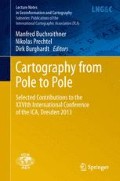Abstract
Spatial component is the key and most likely the first element of map making so that accurate spatial information improves the locational perception of map users. In this regard, soft classified satellite imagery conveys class proportions within pixels; however spatial distribution of the sub-pixels remains unknown. So, different visualization techniques (e.g. pie-chart representation of the proportions) are suggested to communicate the detailed land cover information. However, in each of which, the perception of actual spatial location of sub-pixels is definitely difficult for map users. Recently, the Super Resolution Mapping (SRM) techniques have been developed for optimization of the sub-pixels spatial arrangement based on the concepts of spatial dependency. These are relatively new methods which a comprehensive study on their performance and also their decisive parameters is a central issue for sub-pixel land cover mapping. In this research, the binary Pixel Swapping (PS) algorithm, as a prominent SRM algorithm, is developed for multivariate land cover mapping and the accuracy of the proposed method is evaluated in two procedures of independent and dependent of the soft classification error. Likewise, the impact of some parameters (e.g. zoom factor, neighborhood level and weighting function) is investigated on the efficiency of the algorithm. According to the results, the overall accuracy of the PS technique is extremely dependent on the accuracy of its input data (outputs of the soft classification). Furthermore, as a key result of this chapter, it is indicated that by increasing the zoom factor, the overall accuracy of the algorithm decreases. Also, the second level of neighborhood and inverse/square inverse distance functions has demonstrated the highest accuracies. Considering lower values than 5 for zoom factor, overall accuracy of the algorithm is determined higher than 90 % in procedure of optimizing the sub-pixels spatial arrangement.
Access this chapter
Tax calculation will be finalised at checkout
Purchases are for personal use only
Notes
- 1.
Number of Sub-Pixels (NSP).
References
Atkinson PM (2004) Super-resolution land cover classification using the two-point histogram, In: GeENV IV: geostatistics for environmental applications, pp 15–28
Atkinson PM (2005) Super-resolution target mapping from soft classified remotely sensed imagery. Photogramm Eng Remote Sens 71(7):839–846
Atkinson PM (2009) Issues of uncertainty in super-resolution mapping and their implications for the design of an inter-comparison study. Int J Remote Sens 30(20):5293–5308
Atkinson PM, Cutler MEJ, Lewis H (1997) Mapping sub-pixel proportional land cover with AVHRR imagery. Int J Remote Sens 18:917–935
Bezdek JC, Ehrlich R, Full W (1984) FCM: the fuzzy c-means clustering algorithm. Comput Geosci 10:191–203
Cai S, Du Q, Moorhead R (2007) Hyperspectral imagery visualization using double layers. IEEE Trans Geosci Remote Sens 45(10):3028–3036
Cai S, Moorhead R, Du Q (2011) An evaluation of visualization techniques for remotely sensed hyperspectral imagery. In: Prasad S, Bruce LM, Chanussot J (eds) Optical remote sensing: advances in signal processing and exploitation techniques. Springer, Berlin
Foody GM, Cox DP (1994) Sub-pixel land cover composition estimation using a linear mixture model and fuzzy membership functions. Int J Remote Sens 15:619–631
Foody GM, Muslim AM, Atkinson PM (2005) Super-resolution mapping of the waterline from remotely sensed data. Int J Remote Sens 26(24):5381–5392
Garcia-Haro FJ, Gilabert MA, Meliá J (1996) Linear spectral mixture modelling to estimate vegetation amount from optical spectral data. Int J Remote Sens 17:3373–3400
Holben BN, Shimabukuru YE (1993) Linear mixing model applied to coarse spatial resolution data from multispectral satellite sensor. Int J Remote Sens 14:2231–2240
Jacobson NP, Gupta MR, Cole JB (2007) Linear fusion of image sets for display. IEEE Trans Geosci Remote Sens 45(10):3277–3288
Kasetkasem T, Arora MK, Varshney PK (2005) Super-Resolution land cover mapping using a Markov random field based approach. Remote Sens Environ 96(3–4):302–314
Marcal A (2005) Automatic color indexing of hierarchically structured classified images. In: Proceedings of IEEE geoscience and remote sensing symposium, vol 7, pp 4976–4979
Mertens KC, Verbeke LPC, Ducheyne EI, De Wulf RR (2003) Using genetic algorithms in sub-pixel mapping. Int J Remote Sens 24:4241–4247
Niroumand JM, Safdarinezhad AR, Sahebi MR, Mokhtarzade M (2012) A novel approach to super resolution mapping of multispectral imagery based on pixel swapping technique. ISPRS Ann Photogramm Remote Sens Spatial Inf Sci I-7:159–164. doi:10.5194/isprsannals-I-7-159-2012
Paola JD, Schowengerdt RD (1995) Review article: a review and analysis of back propagation neural networks for classification of remotely sensed multispectral imagery. Int J Remote Sens 16:3033–3058
Richards JA, Jia X (2006) Remote sensing digital image analysis, 4th edn. Springer, Heidelberg
Tatem AJ, Lewis HG, Atkinson PM, Nixon MS (2002) Super-resolution land cover mapping from remotely sensed imagery using a Hopfield neural network. In: Foody GM, Atkinson PM (eds) Uncertainty in remote sensing and GIS. London, Wiley
Thomas LL, Benning VM, Ching NP (1987) Classification of remotely sensed images. Adam-Hilger, Bristol
Thornton MW, Atkinson PM, Holland DA (2006) Super-resolution mapping of rural land cover features from fine spatial resolution satellite sensor imagery. Int J Remote Sens 27:473–491
Tobler W (1970) A computer movie simulating urban growth in the Detroit region. Econ Geogr 46(2):234–240
Villa A, Chanussot J, Benediktsson JA, Jutten Ch (2011) Spectral unmixing for the classification of hyperspectral images at a finer spatial resolution. IEEE J Sel Top Signal Process 5(3):521–533
Wessels R, Buchheit M, Espesset A (2002) The development of a high performance, high volume distributed hyperspectral processor and display system. In: Proceedings of IEEE geoscience and remote sensing symposium, vol 4, pp 2519–2521
Author information
Authors and Affiliations
Corresponding author
Editor information
Editors and Affiliations
Rights and permissions
Copyright information
© 2014 Springer-Verlag Berlin Heidelberg
About this chapter
Cite this chapter
Niroumand Jadidi, M., Sahebi, M.R., Mokhtarzade, M. (2014). Enhancing the Locational Perception of Soft Classified Satellite Imagery Through Evaluation and Development of the Pixel Swapping Technique. In: Buchroithner, M., Prechtel, N., Burghardt, D. (eds) Cartography from Pole to Pole. Lecture Notes in Geoinformation and Cartography(). Springer, Berlin, Heidelberg. https://doi.org/10.1007/978-3-642-32618-9_5
Download citation
DOI: https://doi.org/10.1007/978-3-642-32618-9_5
Published:
Publisher Name: Springer, Berlin, Heidelberg
Print ISBN: 978-3-642-32617-2
Online ISBN: 978-3-642-32618-9
eBook Packages: Earth and Environmental ScienceEarth and Environmental Science (R0)

